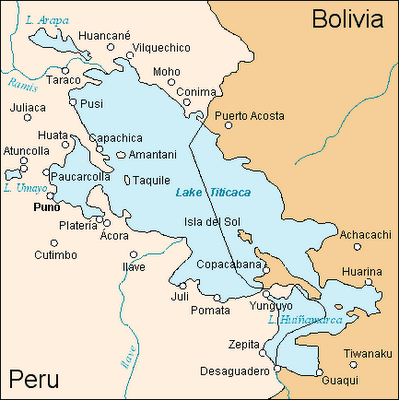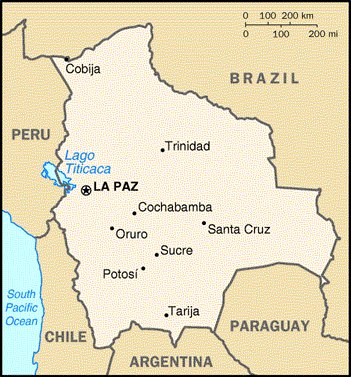International corporate conspiracy, fighting in the streets of Bolivia with tear gas and bullets and a power struggle at the highest levels of international politics and business; it sounds like something from a James Bond novel, but it actually happened in Bolivia in 2000. High in the Andes, trouble had been brewing for fifteen years, but no-one expected it to boil over for the right to drink a glass of water.
Problems for Bolivia
Hyperinflation destroyed the Bolivian economy in 1985, rising at an incredible 25,000%. Foreign investment possibilities were destroyed, and in the financial crisis the World Bank stepped up to loan the government money when no-one else would. As condition for it support, the Bank demanded steady privatization of Bolivian facilities, including airlines, telephone networks and railways. Our story begins in 2000 when, according to The Economist magazine, the World Bank told Bolivia of the possibility that it would not 'renew' a $25 million loan. To secure the loan, the government needed to privatize its water systems, based on concerns about the efficiency and sustainability of the state system.
Enter the Consortium
Bolivia set the wheel in motion to privatize. Only one bid was put in for the state agency SEMAPA; a consortium called Aguas de Tunari formed by foreign corporations Bechtel Enterprise Holdings (USA), International Water Limited (England) and Edison (Italy). Aguas de Tunari projected a water network to provide drinking water to all of the people of Cochabamba, a city in central Bolivia. This was set to double the existing coverage area and also introduce electrical production to more of the region. The Bolivian government under President Hugo Banzer agreed to the terms of its sole bidder Aguas del Tunari and signed a $2.5 billion, 40-year concession to provide water and sanitation services to the residents of Cochabamba, as well as generate electricity and irrigation for agriculture.
Warning signs
To legally support the contract, the government passed Law 2029. Concerns arose amongst Bolivians that it would lead to a monopoly on all water resources; for example, the communal irrigation resources used by farmers that had been independent of regulation. Previously free water could be charged at the discretion of Aguas del Tunari.
Nasty surprises
As soon as they took control of the water supply, the consortium started making some unpopular changes. A 35% rate hike to an average of $20 a month put incredible strain on Bolivian families, the average which earned a monthly income of about $100. Increases were justified as payments towards a dam project. A manager for the consortium made matters worse by threatening to shut off water supplies if Bolivians were unable to pay. The poor quickly joined in protest; their numbers increased when the middle class and business owners lost their government subsidies and their rates also rose.
Panic in the streets
The response to the rate increase began in in January 2000 with a 4 day strike and boiled over into a national state of emergency that created various violent clashes, resulting in numerous injured police and protesters and five deaths. After a televised recording of a 17 year old being shot to death by a Bolivian army Captain, public outcry forced the police to tell the executives of Aguas de Tunari who had been relying on their protection that their safety could no longer be guaranteed. The executives fled to Santa Cruz and resistance to civil protests dissolved. Within days the leader of the resistance, Oscar Olivera, signed an agreement that pushed Aguas de Tunari out of Bolivia and turned Cochabamba's water resources over to the state facilities, revoked Law 2090 and released all the detainees from the conflict.
The aftermath
It all sounds like a happy ending, but for the $40m lawsuit filed by Aguas de Tunari against the Bolivian government for being forced out of Bolivia and violating their mutual contract. The lawsuit was eventually dropped in 2005. In Cochabamba water prices have dropped to pre-2000 levels, but service and supply are still poor and SEMAPA is even more burdened by inefficiency. With an unsuitable budget to expand resources and develop what already exists, Cochabamba seems to be in the bizarre position of exactly where it was fifteen years ago, but with the history of a very messy conflict.
So what do we take away from this story? There's the obvious problem of international corporate interests paying little attention to the needs of the population that they were supposed to be serving, but that's not the most disturbing insight. The reason for the violent and passionate protests by the Bolivian people was due to the fact that they were having their access to water taken away. It's a common saying that "Water is life"; as oil becomes scarce, will we see water become the new global commodity? We can live without oil, but what would happen if our water supply was passing through political or commercial interests?
Gary Sargent is the Managing Director of the tour companies Escaped to Peru and Escaped to Latin America and has lived in South America for over 10 years. Gary is passionate about life here, the people, customs and places. To learn more feel free to click on the links below:
http://www.escapedtoperu.com
http://www.escapedtolatinamerica.com
Toll Free USA / Canada 1-800-305-6543
Free Phone UK 0-800-680-0617
Problems for Bolivia
Hyperinflation destroyed the Bolivian economy in 1985, rising at an incredible 25,000%. Foreign investment possibilities were destroyed, and in the financial crisis the World Bank stepped up to loan the government money when no-one else would. As condition for it support, the Bank demanded steady privatization of Bolivian facilities, including airlines, telephone networks and railways. Our story begins in 2000 when, according to The Economist magazine, the World Bank told Bolivia of the possibility that it would not 'renew' a $25 million loan. To secure the loan, the government needed to privatize its water systems, based on concerns about the efficiency and sustainability of the state system.
Enter the Consortium
Bolivia set the wheel in motion to privatize. Only one bid was put in for the state agency SEMAPA; a consortium called Aguas de Tunari formed by foreign corporations Bechtel Enterprise Holdings (USA), International Water Limited (England) and Edison (Italy). Aguas de Tunari projected a water network to provide drinking water to all of the people of Cochabamba, a city in central Bolivia. This was set to double the existing coverage area and also introduce electrical production to more of the region. The Bolivian government under President Hugo Banzer agreed to the terms of its sole bidder Aguas del Tunari and signed a $2.5 billion, 40-year concession to provide water and sanitation services to the residents of Cochabamba, as well as generate electricity and irrigation for agriculture.
Warning signs
To legally support the contract, the government passed Law 2029. Concerns arose amongst Bolivians that it would lead to a monopoly on all water resources; for example, the communal irrigation resources used by farmers that had been independent of regulation. Previously free water could be charged at the discretion of Aguas del Tunari.
Nasty surprises
As soon as they took control of the water supply, the consortium started making some unpopular changes. A 35% rate hike to an average of $20 a month put incredible strain on Bolivian families, the average which earned a monthly income of about $100. Increases were justified as payments towards a dam project. A manager for the consortium made matters worse by threatening to shut off water supplies if Bolivians were unable to pay. The poor quickly joined in protest; their numbers increased when the middle class and business owners lost their government subsidies and their rates also rose.
Panic in the streets
The response to the rate increase began in in January 2000 with a 4 day strike and boiled over into a national state of emergency that created various violent clashes, resulting in numerous injured police and protesters and five deaths. After a televised recording of a 17 year old being shot to death by a Bolivian army Captain, public outcry forced the police to tell the executives of Aguas de Tunari who had been relying on their protection that their safety could no longer be guaranteed. The executives fled to Santa Cruz and resistance to civil protests dissolved. Within days the leader of the resistance, Oscar Olivera, signed an agreement that pushed Aguas de Tunari out of Bolivia and turned Cochabamba's water resources over to the state facilities, revoked Law 2090 and released all the detainees from the conflict.
The aftermath
It all sounds like a happy ending, but for the $40m lawsuit filed by Aguas de Tunari against the Bolivian government for being forced out of Bolivia and violating their mutual contract. The lawsuit was eventually dropped in 2005. In Cochabamba water prices have dropped to pre-2000 levels, but service and supply are still poor and SEMAPA is even more burdened by inefficiency. With an unsuitable budget to expand resources and develop what already exists, Cochabamba seems to be in the bizarre position of exactly where it was fifteen years ago, but with the history of a very messy conflict.
So what do we take away from this story? There's the obvious problem of international corporate interests paying little attention to the needs of the population that they were supposed to be serving, but that's not the most disturbing insight. The reason for the violent and passionate protests by the Bolivian people was due to the fact that they were having their access to water taken away. It's a common saying that "Water is life"; as oil becomes scarce, will we see water become the new global commodity? We can live without oil, but what would happen if our water supply was passing through political or commercial interests?
Gary Sargent is the Managing Director of the tour companies Escaped to Peru and Escaped to Latin America and has lived in South America for over 10 years. Gary is passionate about life here, the people, customs and places. To learn more feel free to click on the links below:
http://www.escapedtoperu.com
http://www.escapedtolatinamerica.com
Toll Free USA / Canada 1-800-305-6543
Free Phone UK 0-800-680-0617

